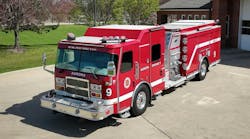Is this a testament to the failure of fire prevention and fire safety education programs? Regardless, the public's neglect of fire safety increases fire department responses. Demands for the fire service to provide emergency medical services is placing further strain on manpower and the functional role fire apparatus must perform.
Despite America's leadership in technology, there appears to be a lack of major advancement in fire apparatus design. How proud we are of the coming of fully enclosed cabs, roll-up doors and sexless couplings. We hailed the innovation of large-diameter fire hose, the rear-mounted aerial ladder and the rear-mounted fire pump. Let us not forget our European counterparts were using these designs before World War II.
The mindset of "200 years of tradition unimpeded by progress" is archaic. It is time to plan intelligently for the future.
Granted, we have developed advanced foam systems, automatic nozzles, rescue tools and thermal imaging devices. Does our apparatus match up to the advances made in personal protective clothing, self-contained breathing apparatus (SCBA), training and safety? What we appear to be lacking is how well we package our resources on our vehicles. For eons, the fire service has carte blanche accepted the apparatus designs presented by the manufacturers. Why?
The days of single-function apparatus, the traditional engine and ladder companies, are gone. Apparatus of the future will be serving dual and multi-function roles.
The transition has already started. Rural fire departments use combination pumper-tankers. St. Louis utilizes an all-quint concept. The trend on the West Coast is two-piece ladder companies, the aerial and a tender. Combination pumper-rescue trucks are commonplace. Will we see a return of the two-piece engine company? Will it be a downsized class A pumper with an expendable EMS squad car? Will it be a pumper and hose wagon? Perhaps the wagon will be a cost-effective, easily replaced hose carrier that also carries EMS equipment and other items we can't find room for on today's engines.
Will the mini-pumper return in its originally intended role as the first out unit for a two-piece engine company? Two-piece companies can work providing they operate together. Or, will we see the dual-function units evolve into huge pieces of overly long, overly wide and overweight pieces of iron trying to maneuver through our streets? Perhaps the fire service will again become the quasi-military organization it once was, and buy apparatus engineered for the weather and terrain of individual response areas.
Will custom-built and custom-designed apparatus be commonplace and the standard production line truck be one of the past? How innovative is the fire department that just purchased a new piece with the two standard 1 3/4-inch pre-connects, capped 2 1/2-inch discharges on each side and a minimum-sized hose bed? That reeks of the early '60s. Is your new fire truck reflective of how effectively you actually fight fires? The key should be in the packaging of the total product in a manner that emphasizes firefighter safety and ease of operation on the fireground. Apparatus must be designed to make better use of the most valuable resource our people. Place as much emphasis on design and engineering as you do on quality and workmanship.
What good are 10 pre-connects on a pumper if you can't reach them from the ground? That $3,000 combination portable monitor/deck gun isn't worth a dime if you can't quickly put it into operation. Why would you put 50-pound foam pails up in the front of the hose bed? Shouldn't they be right next to the pump operator? Why isn't every discharge pre-connected? The National Fire Protection Association (NFPA) recommends carrying a 35-foot extension ladder that weighs 125 pounds on engines. It is bad enough we don't have enough people to put it into service, so why do we put it up so high on our apparatus that we need a stepladder just to remove it?
What a radical change in protocol it would be to let firefighters help design their trucks! I bet the hydrant man wants his gates down on the rear step. And the nozzleman wants his line where it can be easily and quickly stretched. Do you think the pump operator who has to draft wants her hard sleeves stored up higher than the lightbar? We teach our "truckies" how to execute a one-person ladder throw in training. Did we design our truck to let one of them remove a ladder by himself or herself? I'll also wager the engine company officer would like a choice of multiple size and length pre-connected lines. Wouldn't a medical compensation board love to see a firefighter attempting to exit a $100,000 cab and chassis wearing an SCBA, carrying a hand lantern, fumbling with an axe and halligan bar and possibly holding his helmet? How many hands will he have for himself? How easy is it for a three-person engine company to repack a supply line? The driver may not have a problem but the two people putting the hose into the bed probably would like a walkway.
The pessimists will scream about the cost of having it your way but times have changed. Ask that medical compensation board how much it would cost if a 30-year-old firefighter slips off a shiny treadplate running board, breaks his or her back and is disabled for life. Invite your key administrators and public officials to the fire station. Ask that 5-foot-2 village board member to pull off and shoulder load a pre-connect that is seven feet in the air. Invite the mayor and the council members to the fire station and let them repack a wet load of supply hose. Have two of the most experienced, and probably the oldest, members of your truck committee individually pull off a length of hard suction or an extension ladder. Have the chief try it. They'll probably see the light. Invite the president of the chamber of commerce or the head of the Rotary Club to the firehouse for a hands-on show-and-tell program. There is a big difference in justifying what you need and asking for what you want.
What impact would compensable injuries have on your insurance and disability costs? Are your career firefighters taking early retirement because they are burned out? Do we lose our volunteers because we inadvertently make their lives miserable and difficult on the fireground because of the trucks we purchase?
There is no doubt every firefighter, career or volunteer, belongs to the ranks because he or she wants to be there. The workload is increasing and the manpower is decreasing. The overburdened fire service is expected to do more with less. Fire apparatus that are sensibly and functionally designed, safety oriented and user friendly will make the job easier.
Winter Maintenance Tips For Apparatus Operation
- Always check your belts at least once a year for wear and cracking. All belts should be changed a minimum of once every two years.
- Departments in northern climates must make sure fuel suppliers have shipped the proper winterized fuel for their states. This will prevent jelling. The winterized fuel will usually carry a 1-D specification and have a lower volumetric heat content than the standard 2-D fuel. Using 1-D fuel will reduce engine output by as much as 5 percent; however, this should be a small price to pay to avoid trouble in cold operation periods. (Note: If you use any additives in your fuel, it is recommended to first check with your engine manufacturer.)
- A complete fluid change is STRONGLY recommended at least yearly. This should include all filters, engine oil, transmission fluid, rear axle oil, transfer case pump transmissions, etc. Improper oil and grease lubricants are the major cause of premature failure. All components have different lubricants; you should check your owner's manual or contact each specific manufacturer for recommendations.
- All radiators must be checked with a refractometer anti-freeze tester. Most engine manufacturers recommend that the coolant be changed at least every two years. Check with your specific engine manufacturer to avoid any damage to your engine and the possibility of voiding your warranty. Ask the engine manufacturer if you need a low- or high- silicate anti-freeze. The system should be pressure tested for leaks or damage. Remove the thermostat, clean and check for proper operation. Always make sure that the front of the radiator is clean and free of debris.
- All brake components should be regularly inspected and adjusted if necessary.
- Inspect all suspension components.
- Inspect tires, check for wear, cuts, etc. Check lug nuts and if you use tire chains, now is the time to check them carefully.
- Replace windshield wiper blades, fill windshield wiper washer reservoir and make sure they are working properly.
- Check the heater and defroster to make sure they are in good working condition.
- Check all air tanks for moisture and drain if necessary.
- Inspect all electrical connectors for corrosion. Make sure all connectors are tight.
- Inspect the cab and body for any loose or hanging wires. Oil and lubricate all doors.
- Check the air cleaner and all of the air intake seals to make sure they are clean and properly fitted.
(Courtesy of Joe Williams, Fire Apparatus Manufacturers Association)
William E. Adams, an active volunteer firefighter since 1962, is an ex-chief of the East Rochester, NY, Fire Department. He is employed as an independent fire apparatus dealer.





